Introducing New Zealand�s Fungi
Fungi are one of the largest groups of organisms in New Zealand, and are very common in forests, parks, farms, streams, and also around the home. You may find them decaying wood and leaves, recycling nutrients for plants, helping plants absorb food, being themselves food for insects and other animals,
or causing diseases of plants and animals, including us. While it�s been estimated there are 20�24,000 different kinds (species) of fungi in New Zealand, only about 1/3 (7,500 species) have been discovered so far. In this introductory guide we are not including the many lichenised fungi (more often
known as lichens) � their structure is mainly fungal tissue with the colour and ability to photosynthesise coming from the associated microscopic algal cells.
Iconic fungi
How to identify fungi
10 suggested books for further reading
Iconic fungi
Among our fungi are many that are distinctive and special to New Zealand. These include:
|
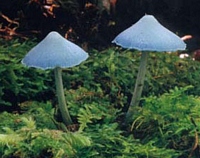 Sky-blue mushroom (Entoloma hochstetteri), a brilliant blue-coloured mushroom featured on our NZ$50 bank note along with the
kokako bird � the kokako has a wattle on its cheek of the same colour. Sky-blue mushroom (Entoloma hochstetteri), a brilliant blue-coloured mushroom featured on our NZ$50 bank note along with the
kokako bird � the kokako has a wattle on its cheek of the same colour.
|
|
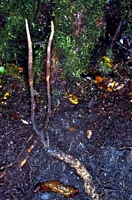 Vegetable caterpillar (Cordyceps robertsii), a native parasite of certain native caterpillars where the fungus eats out the inside of the caterpillar
to form a mummy and then forms a fruiting body by growing out through its head � not a pleasant experience for the caterpillar! This was the first fungus to be described as a new species from New Zealand. Vegetable caterpillar (Cordyceps robertsii), a native parasite of certain native caterpillars where the fungus eats out the inside of the caterpillar
to form a mummy and then forms a fruiting body by growing out through its head � not a pleasant experience for the caterpillar! This was the first fungus to be described as a new species from New Zealand.
|
|
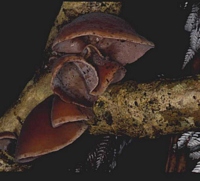 Wood ear (Auricularia cornea), a native, ear-shaped, wood decay fungus in forests, and New Zealand�s only exported native fungus � known
locally as "Taranaki Wool", huge quantities were sent to China in late 19th/20th C. Wood ear (Auricularia cornea), a native, ear-shaped, wood decay fungus in forests, and New Zealand�s only exported native fungus � known
locally as "Taranaki Wool", huge quantities were sent to China in late 19th/20th C.
|
|
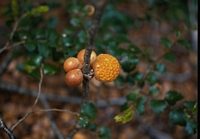 Beech strawberry (Cyttaria sp.), a native parasite of beech trees causing a cancer-like growth (gall) on branches and forming yellow golfball-like
fruiting bodies that are eaten by pigeons and other animals. Beech strawberry (Cyttaria sp.), a native parasite of beech trees causing a cancer-like growth (gall) on branches and forming yellow golfball-like
fruiting bodies that are eaten by pigeons and other animals.
|
|
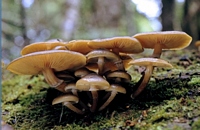 Bootlace mushroom (Armillaria spp.), native mushrooms that cause wood decay of living and dead trees. It can also cause serious
diseases of kiwifruit and pine trees. One kind is edible and was widely collected and eaten by Maori; known as "harore" this term is also the best Maori word for fungi in general. Bootlace mushroom (Armillaria spp.), native mushrooms that cause wood decay of living and dead trees. It can also cause serious
diseases of kiwifruit and pine trees. One kind is edible and was widely collected and eaten by Maori; known as "harore" this term is also the best Maori word for fungi in general.
|
|
Sooty mould, the black carpet often covering trunks of beech trees. This carpet is a mixture of several kinds of dark-coloured fungi that feed on sugary honey-dew produced by sap-sucking native scale insects.
|
|
Autumn mushroom carpets, carpets of a different kind composed of colourful mushrooms and truffle-like fungi of many different species forming on soil in beech forests. Beneath each mushroom is a direct connection to living roots of a beech tree (a beneficial relationship known as "ectomycorrhiza"
meaning "fungus-root") where the fungus helps the tree absorb food while itself getting food from the tree root.
|
|
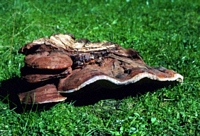 Ganoderma sp. "Awaroa" Ganoderma sp. "Awaroa"
|
While this introductory guide to New Zealand fungi deals mainly with those fungi that have large fruiting bodies, a majority of fungi in fact have microscopic fruiting structures. And all have a feeding stage, typically hidden within soil, wood, or other material, that is made up of microscopic parts
(usually tiny threads called "hyphae"). Examples of microscopic fungi are of those that cause diseases, for example, diseases of crop and native plants, diseases of animals such as facial eczema in sheep (due to a fungal toxin) and a fatal disease in native frogs.
Some fungi are threatened with extinction mainly due to habitat loss. Forty-nine species of fungi are listed by the Department of Conservation as "Nationally Critical", among New Zealand�s most threatened species. An example is a bracket fungus (Ganoderma sp.) known only from the Waikato and last seen
in 1972.
Use the section on "how to identify fungi" and the "simple key" to help identify mushrooms and other fungi that you find. We will progressively add to the number and range of fungi included in this website.
[Illustrations yet to be provided: thumbnail for all species mentioned above.]
^ to top ^
How to identify fungi
This brief guide to fungal identification is mainly confined to characteristics observable with the naked eye and to those fungi that produce large fruiting bodies. A hand lens (e.g., 5-10 x magnification as purchased from an optician) is helpful for some subtle macroscopic characters. Identification
of many fungi, however, requires use of a microscope; microscopic features are not discussed here.
Use of the simple key is intended to help identify some of the most common and distinctive New Zealand fungi, assisted by images and brief descriptions. For this key, fungi are arranged in two large groups � basidiomycetes (mushrooms, brackets, puffballs, coral fungi,
etc.) that form their microscopic spores, mostly 4 at a time, directly from a cell known as a basidium; and ascomycetes (truffles, cup fungi, many parasitic fungi) that form their spores, mostly in groups of 8, inside a tiny sac known as an ascus.
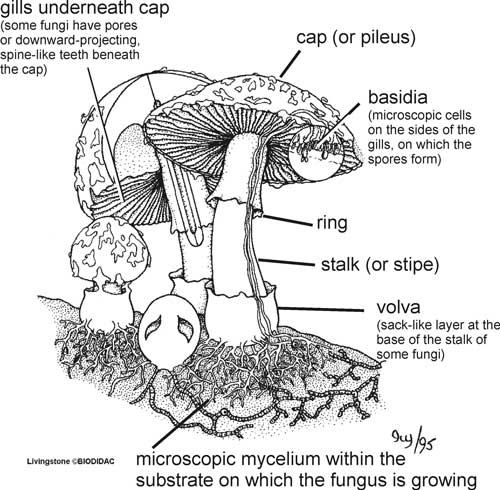
Key features to note when looking at a fungal fruiting body include:
Form of fruiting body
What type of fruiting body is it? Use the diagrams and photos on the first page of the simple key to identify the general type of fruiting body.
Lower surface
If the fruiting body has a cap, shelf, or otherwise a distinct upper and lower surface, check the features, particularly of the lower (often spore-producing) surface. Does the lower surface have gills, or tubes opening as pores, or teeth, or is it smooth? External features? If the fungus is a mushroom,
check if there is a ring(s) on the stalk, a broken cup-like structure (volva) at the base of the stalk, where the stalk attaches to the cap (central or to the side?), and whether there are scales on the stalk and upper surface of the cap � see diagram.
Colour of fruiting body
What colours are the different parts of the fruiting body, best noted when fresh as with age and bruising the colour may change � this change may be diagnostic, too. Smell, texture. Is there a distinctive smell or texture?
Colour of spores
Note that spore colour may differ from the colour of the spore-producing surface. A natural �spore print� might be visible immediately below a mature mushroom if spores have accumulated in sufficient quantity. Colours vary from white to pink, green, brown, or black.
Location
Where the fungus is found � on or under what? Note: the non-reproductive/feeding stage of the fungus will be beneath or beside where you see the fruiting body.
Host or associate
What plant or other organism(s) is it associated with, and what part? What vegetation is nearby? Disease-causing? Is the fungus causing an apparent disease symptom, e.g., wood rot of living tree?
Season
What is the time of year? Different fungi may fruit during particular seasons.
^ to top ^
10 suggested books for further reading
- Bell, A. 1983: Dung Fungi, an Illustrated Guide to Coprophilous Fungi in New Zealand. Wellington, Victoria University Press.
- Buchanan, P.K.; May, T.W. 2003: Conservation of New Zealand and Australian fungi. New Zealand Journal of Botany 41: 407�421.
- Galloway D.J. 2005: Flora of New Zealand Lichens, Revised Second Edition, Including Lichen-forming and Lichenicolous Fungi. Lincoln, Manaaki Whenua Press.
- Glare, T.R.; O�Callaghan, M.; Wigley, P.J. 1993: Checklist of naturally-occurring entomopathogenic microbes and nematodes in New Zealand. New Zealand Journal of Zoology 20: 95�120.
- Hood, I.A. 1992: An Illustrated Guide to Fungi on Wood in New Zealand. Auckland, Auckland University Press.
- Hughes, S.J. 1976: Sooty moulds. Mycologia 68: 693�820.
- McKenzie, E.H.C. (ed.) 2004: Introduction to Fungi of New Zealand. Fungi of New Zealand 1: 1�498.
- McKenzie, E.H.C.; Buchanan, P.K.; Johnston, P.R. 2000: Checklist of fungi on Nothofagus species in New Zealand. New Zealand Journal of Botany 38: 635�720.
- Stephenson, S.L. 2003: Myxomycetes of New Zealand. Fungi of New Zealand 3: 1�238.
- V�nky, K.; McKenzie, E.H.C. 2002: Smut Fungi of New Zealand. Fungi of New Zealand 2: 1-259.
^ to top ^